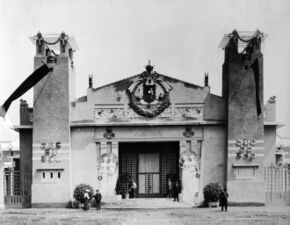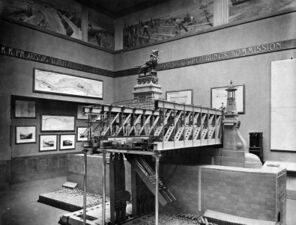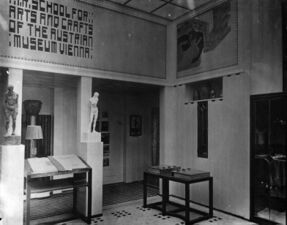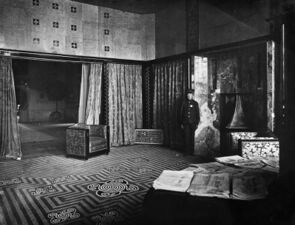Austria: Difference between revisions
No edit summary |
No edit summary |
||
| (3 intermediate revisions by the same user not shown) | |||
| Line 1: | Line 1: | ||
{{ | {{SHORTDESC:Austria National Pavilion}} | ||
{{Infobox | {{Infobox FairBuilding | ||
| name = Austria National Pavilion | | name = Austria National Pavilion | ||
| image = Austria National Pavilion.jpg | | image = Austria National Pavilion.jpg | ||
| image_size = | | image_alt = | ||
| image_size = 400px | |||
| caption = Austria National Pavilion | | caption = Austria National Pavilion | ||
| alternate_name = | | alternate_name = | ||
| | | location = [[Place of Nations]] | ||
| | | no_buildings = 1 | ||
| | | construction_cost= | ||
| | | furnishing_cost = | ||
| profit = | | profit = | ||
| owner = | | owner = | ||
| | | architect = | ||
| | | dimensions = | ||
| | | adult_entry = | ||
| child_entry = | |||
| opening_day = | |||
| dedication_day = | |||
| special_day = | |||
| other = | | other = | ||
}} | }} | ||
Austria's pavilion was stylistically Viennese, and the only sample of the art nouveau among the foreign nations. It was first built in Austria, taken to pieces and reconstructed | Austria's pavilion was stylistically Viennese, and the only sample of the art nouveau among the foreign nations. It was first built in Austria, taken to pieces and reconstructed on the [[Place of Nations]] after its arrival at the World's Fair. | ||
== | ==Description== | ||
Unlike the national pavilions of most of the foreign countries represented at the Exposition, the Austrian building was filled with exhibits, many of them rare works of art contributed by various art societies of Bohemia, Poland, Austria, Transylvania and other sections of the Austrian Empire, including of course, Vienna, the great art center of the country. | |||
The ground plan of the building was shaped like a capital T; the wing pointing toward the front. On either side of this front wing were gardens and fountains, embellished with sculpture. The front of the building was flanked by square towers, 47 feet high, of peculiar design in the style of the art nouveau and again, enriched with sculpture. | The ground plan of the building was shaped like a capital T; the wing pointing toward the front. On either side of this front wing were gardens and fountains, embellished with sculpture. The front of the building was flanked by square towers, 47 feet high, of peculiar design in the style of the art nouveau and again, enriched with sculpture. | ||
The exterior walls were adorned with paintings of pastoral scenes executed by Austrian artists, and the corner pillars of the wall which enclosed the gardens were capped with sculptural figures. | The exterior walls were adorned with paintings of pastoral scenes executed by Austrian artists, and the corner pillars of the wall which enclosed the gardens were capped with sculptural figures. | ||
Inside the building were 13 salons- decorated in dark green and burlap, one for each of the governmental departments, in which special exhibits were kept. There were | Inside the building were 13 salons - decorated in dark green and burlap, one for each of the governmental departments, in which special exhibits were kept. There were relief models of the Government mountain railroads, showing bits of fine scenery along the routes; also a model of the greatest railway bridge in the world over the Isonzo river. | ||
A large portion of the Austrian art display was housed here, rather than in the Palace of Fine Arts. | A large portion of the Austrian art display was housed here, rather than in the Palace of Fine Arts. | ||
The noted art exhibit showed samples of "new art, " as well as distinctive paintings of the Polish, Bohemian and Vienna artists' associations. The work of 46 art and crafts schools (including the imperial Royal School of Arts and Crafts), | The noted art exhibit showed samples of "new art," as well as distinctive paintings of the Polish, Bohemian and Vienna artists' associations. The work of 46 art and crafts schools (including the imperial Royal School of Arts and Crafts), was also on display including a fine array of artistic wood carving. | ||
Fine lace handkerchiefs sold at the state building for $150 to $175 ({{Inflation|US|175|1904|fmt=eq}}) (quite expensive for the day). Vases, glassware and other items could be purchased as well. | Fine lace handkerchiefs sold at the state building for $150 to $175 ({{Inflation|US|175|1904|fmt=eq}}) (quite expensive for the day). Vases, glassware and other items could be purchased as well. | ||
==After the Fair== | ==After the Fair== | ||
==Gallery== | |||
<gallery | class="center" | mode=packed-hover | widths=150px heights=150px>> | |||
File:Austria - Outdoor Fountain.jpg | Outdoor Fountain | |||
File:Austria - Front Entrance.jpg | Front Entrance to the Austria Pavilion | |||
File:Austria - Interior.jpg | Interior of the Austrian Pavilion | |||
File:Austria - Austrian Museum Hall.jpg | Austrian Museum Hall | |||
File:Austria - Austrian Museum.jpg | Austrian Museum Hall | |||
File:Austria - Carpet Display.jpg | Carpet Display | |||
File:Austria - Commissioner in Parlor.jpg | The Austrian Commissioner in the Parlor | |||
File:Austria - Imperial Austrian Art.jpg | Imperial Austrian Art | |||
File:Austria - Painting of Railway System.jpg | Painting of the Austrian Railway | |||
File:Austria - Painting of Railway.jpg| Painting of the Austrian Railway | |||
File:Austria - Prague Art School.jpg|Prague Art School Exhibit | |||
File:Austria - The Weaver Painting.jpg |'The Weaver' Painting | |||
</gallery> | |||
==See also== | ==See also== | ||
| Line 48: | Line 67: | ||
[[Category: | [[Category:Place of Nations]] | ||
Latest revision as of 04:29, 26 November 2022
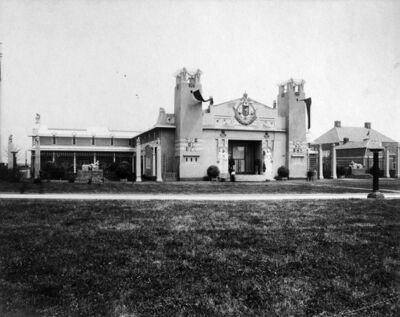 | |
| Location | Place of Nations |
|---|---|
| No. of Buildings | 1 |
Austria's pavilion was stylistically Viennese, and the only sample of the art nouveau among the foreign nations. It was first built in Austria, taken to pieces and reconstructed on the Place of Nations after its arrival at the World's Fair.
Description[edit | edit source]
Unlike the national pavilions of most of the foreign countries represented at the Exposition, the Austrian building was filled with exhibits, many of them rare works of art contributed by various art societies of Bohemia, Poland, Austria, Transylvania and other sections of the Austrian Empire, including of course, Vienna, the great art center of the country.
The ground plan of the building was shaped like a capital T; the wing pointing toward the front. On either side of this front wing were gardens and fountains, embellished with sculpture. The front of the building was flanked by square towers, 47 feet high, of peculiar design in the style of the art nouveau and again, enriched with sculpture.
The exterior walls were adorned with paintings of pastoral scenes executed by Austrian artists, and the corner pillars of the wall which enclosed the gardens were capped with sculptural figures.
Inside the building were 13 salons - decorated in dark green and burlap, one for each of the governmental departments, in which special exhibits were kept. There were relief models of the Government mountain railroads, showing bits of fine scenery along the routes; also a model of the greatest railway bridge in the world over the Isonzo river.
A large portion of the Austrian art display was housed here, rather than in the Palace of Fine Arts.
The noted art exhibit showed samples of "new art," as well as distinctive paintings of the Polish, Bohemian and Vienna artists' associations. The work of 46 art and crafts schools (including the imperial Royal School of Arts and Crafts), was also on display including a fine array of artistic wood carving.
Fine lace handkerchiefs sold at the state building for $150 to $175 (equivalent to $5,278 in 2021) (quite expensive for the day). Vases, glassware and other items could be purchased as well.
After the Fair[edit | edit source]
Gallery[edit | edit source]
-
Outdoor Fountain
-
Front Entrance to the Austria Pavilion
-
Interior of the Austrian Pavilion
-
Austrian Museum Hall
-
Austrian Museum Hall
-
Carpet Display
-
The Austrian Commissioner in the Parlor
-
Imperial Austrian Art
-
Painting of the Austrian Railway
-
Painting of the Austrian Railway
-
Prague Art School Exhibit
-
'The Weaver' Painting

